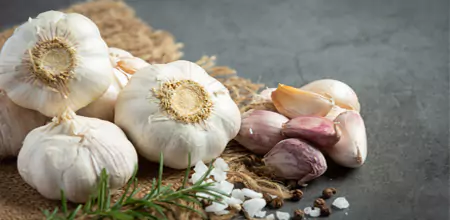Garlic has been cultivated and enjoyed for thousands of years. Ancient civilizations across the Mediterranean and Asia used it as both food and traditional medicine. Egyptian workers were reportedly given garlic for strength, while Greek and Roman writings praise garlic’s role in daily diets. Today, garlic is global — used in sauces, roasts, condiments, and countless regional specialties.
2. What’s inside a clove: nutritional snapshot
Even a small clove of garlic packs vitamins, minerals, and flavor compounds. A typical clove (≈3 g) delivers small amounts of vitamin C, B6, manganese, and trace minerals. The most discussed compound is allicin, a sulfur-containing molecule produced when garlic is crushed. Allicin contributes to garlic’s aroma and is believed to be behind many of its traditional uses.
- Calories per clove: ~4
- Key micronutrients: vitamin C, vitamin B6, manganese
- Active compound: allicin (formed when raw garlic is chopped or crushed)
3. Practical benefits and common uses
Garlic is primarily a culinary ingredient, but it’s also been used traditionally for various supportive roles. Important: avoid presenting garlic as a medical cure. Instead, think of it as a food that may support overall wellness when combined with a balanced lifestyle.
In the kitchen
Garlic adds depth and complexity to savory dishes. Use it raw for bite and heat, sauté for softer flavor, or roast whole bulbs for a sweet, milder profile. It pairs beautifully with olive oil, tomatoes, greens, legumes, fish, and meats.
Traditional uses
Historically, garlic has been applied for wound cleaning, used in poultices, and consumed for respiratory comfort. Modern food traditions continue to use it as a flavor and digestive companion.
4. How to prepare garlic for best flavor and benefit
To maximize flavor and the activity of allicin, crush or mince garlic and let it rest for 8–10 minutes before cooking. This resting time gives the enzymatic reaction that produces allicin time to occur. If you’re after a milder taste, roast garlic bulbs for 35–45 minutes until soft and caramelized.
Minced into dressings, vinaigrettes, or mixed into salsas for a punchy finish.
Sauté quickly in oil for bases like sofrito, stir-fries, and sauces; avoid burning as it turns bitter.
Whole bulbs yield creamy cloves perfect as spreads or mixed into mashed vegetables.
5. Easy recipes and ideas
Here are a few simple ways to add garlic to meals:
- Garlic-olive oil dip: Mix crushed garlic with good olive oil, a pinch of salt and lemon — excellent on bread or roasted veg.
- Roasted garlic mash: Fold roasted cloves into mashed potatoes or caulifower for a mellow garlic boost.
- Garlic herb dressing: Combine minced garlic, parsley, lemon, olive oil and a touch of honey for salads or grilled veg.
6. Safety, side effects, and interactions
Garlic is generally safe for most people when used in normal food amounts. Some people may experience digestive discomfort, heartburn, or garlic breath. In larger supplemental doses, garlic can increase the risk of bleeding for people taking blood-thinning medications. If you take prescription medication or have a medical condition, consult a healthcare professional before using high-dose garlic supplements.
Pregnant or breastfeeding: Eating normal amounts of garlic in food is considered safe; discuss supplements with a clinician.
7. Growing, storing, and choosing garlic
Choose firm, plump bulbs with tight skins. Store in a cool, dry, dark place with good airflow — a mesh bag or open basket works well. Garlic can be grown in home gardens in many climates; plant in fall in colder regions or in early spring in mild climates.
8. Myths and fun facts
Garlic folklore is colorful: from being used as protection in myths to being prized for its strength-building reputation among workers in ancient times. A few fun notes:
- Crushing garlic releases the enzyme alliinase and forms allicin — the characteristic aroma.
- Garlic has been celebrated across cultures for both culinary and household uses.
- Different varieties (softneck, hardneck) have distinct flavors and storage qualities.
Conclusion
Garlic is a small ingredient with big impact. Whether you want to lift the flavor of a simple dish or explore traditional culinary medicine, garlic is easy to add and hard to ignore. Use it fresh, roasted, or sautéed, pay attention to how you prepare it, and enjoy the vibrant flavor it brings to everyday cooking.
Note: The information here is for educational and culinary purposes. It is not medical advice. Consult a licensed professional for personalized medical guidance.
